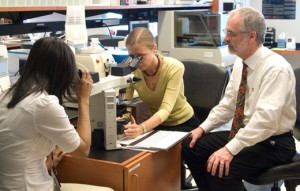
The Pap smear – also called Pap test – is part of the standard annual wellness exam for women’s health and used as a first step in detecting cervical cancer. But according to a recent article published in the International Journal of Cancer, the Pap test may not provide reliable results for certain types of cancer that are harder to detect.
Kevin Ault, MD, associate professor of obstetrics and gynecology at Emory University School of Medicine and investigator at the Emory Vaccine Center conducted a post-hoc analysis of the FUTURE I and FUTURE II (Gardasil) vaccine trials. Based on that analysis Ault, a leading expert and pioneer in the field of human papilloma virus (HPV), says a regular Pap test is not always effective in diagnosing adenocarcinoma, because it starts high up in the cervical canal and may not be sampled by the Pap smear.
“There are a number of reasons the Pap smear could lead to inaccurate results. For example, the pathologist examining the cells could make an error, the gynecologist may not sample the cervix adequately or an infection could obscure the results,†says Ault.
According to Ault, andenocarcinoma is the second most common type of cervical cancer, accounting for about 20 percent of all cervical cancer cases. While the overall incident of cervical cancer is on the decline, Ault reports the proportion of cervical cancers that are andenocarcinoma is rising.
Cervical cancer is the eighth most common type of cancer in American women. More than 12,000 new cases of invasive cervical cancer are diagnosed each year, and more than 4,200 women in the U.S. die from of this disease annually* according to the American Cancer Society. Scientists believe that pre-invasive cervical cancer may develop over a period of months or years after the cervix is infected with the sexually transmitted HPV.
“The take-away from this recent paper is the HPV test would be a better test for the harder to detect adenocarcinoma cervical cancer, if not all cervical cancer,†says Ault.
* 2010 data















